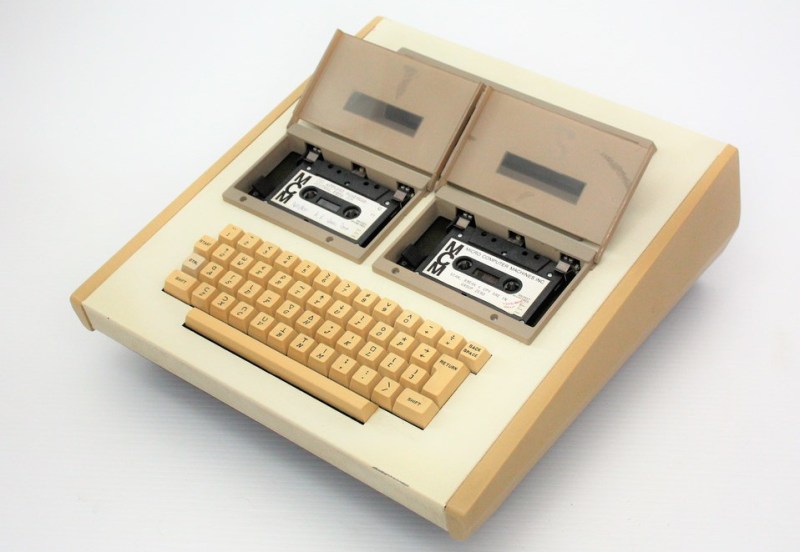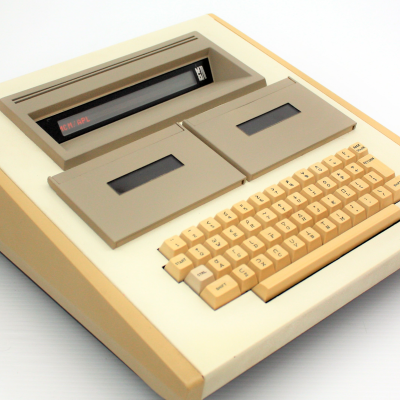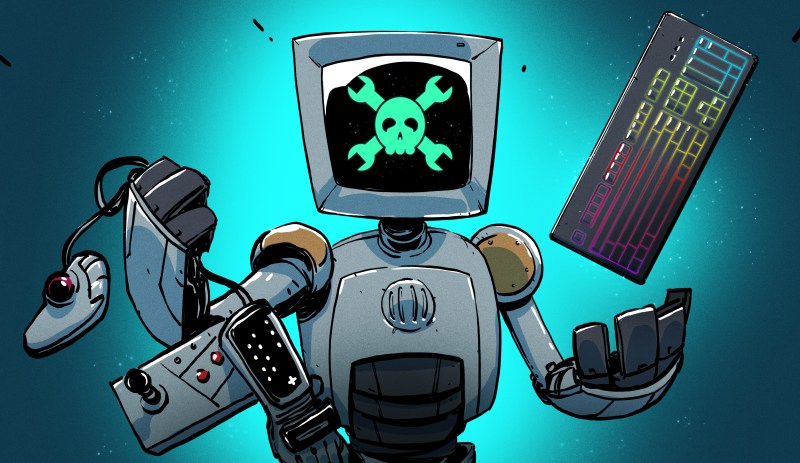Not to start a debate in the comments or anything, but what would you say was the first microcomputer, or personal computer? We suppose the answer depends on your definition. Some would argue that the PC was born at Xerox PARC with a curious portrait-mode display and a three-button mouse, while others would say it all began in a garage in either Los Altos, California or Albuquerque, New Mexico.
If you take the term ‘computer’ to mean that which can crunch big numbers fairly quickly, then the Canadian-made MCM/70 is arguably the first personal computer in that it is portable, has an alphanumeric keyboard, a display, and supports cassette storage, which could be used to extend the 8K of memory. It was an all-in-one computing solution, and it could have an optional telephone modem built in. This was a forward-thinking machine for 1974.
A General-Purpose Personal Computer
We’re all used to personal computers as the norm, be they mobile, laptop, or desktop. But of course, in the early days, computers were large single-purpose machines used to crunch even bigger numbers. Go back even further in time, and the computers are humans operating fancy electromechanical calculators at high speeds, or, simply using pencils or chalk.
Before the personal computer arrived, people had to share time on mainframe machines to do their computing. Imagine having to go down to the library every time you wanted to look something up on the Internet. Wouldn’t you much rather do it at home on your own machine? Of course you would.

In the late 1960s, professor Mers Kutt of Queen’s University in Kingston, Ontario was tired of watching the efficiency of mainframe computer users be hampered by the long wait times involved in submitting programs. Kutt started a company in 1968 and built a data entry terminal with a one-line display that eradicated the need for punching cards.
Kutt wanted to build a different machine to support development of APL, a new programming language full of math symbols that was best programmed on a custom keyboard. He began a new company, Micro Computer Machines (MCM) to build the devices, which look like primitive cyberdecks that weighed 20 pounds.
A Luggable, Math-Minded Cyberdeck
The MCM/70 was designed to be an affordable, general purpose computer, if you consider $9,800 for the fully-equipped model in 1974 “affordable”. It’s based on the 800 KHz Intel 8008 and is one of the first commercial computers to use the CPU. The display was a 32-character glass plasma number that supported scrolling.

These machines came a couple of different ways: they either had no cassette decks at all, one cassette deck and one acoustic coupler for uploading programs to other machines, or two cassette decks. There was an APL interpreter built into the ROM, and a battery to save the workspace when powered down. They could even be rigged to run on battery power.
The MCM/70 had a specialized keyboard with QWERTY and APL legends, ISO Enter, and a honkin’ 9u space bar. Like any vintage computer, we’d love a crack at clacking on it. Be sure to check out all the pictures on this Vintage Computers of Canada site.
Of course, this type of computing power did not come cheap, and wouldn’t have typically been found in the average consumer’s home, which is arguably how many people might describe the personal computer. These minicomputers and their successors were mostly sold to companies and government institutions that needed to make big calculations. Various hospitals and insurance companies along with NASA and the US Army were a few of MCM’s customers, and they sold hundreds of units within a handful of years.
So What Happened?
It may have been a problem of passion. The book Inventing the PC: the MCM/70 Story alleges that Mers Kutt was neither a hacker nor a hobbyist; he was instead an entrepreneur and inventor who simply saw a market and found a partner to help him realize his vision. Nevertheless, he persisted.
According to Inventing the PC, there was a ‘devastating power struggle’ between Kutt and some of MCM’s investors. By the late 1970s, they began to see competitors offering the same amount of computing power, and MCM were designing an improved machine in response. As the story goes, they didn’t have the funding to fuel the rapid development required to beat the competition to market. By 1983, MCM was out of business.
Kutt started one final company called All Computers, Inc. and ended up suing Intel, alleging that they used his patented circuitry inside Intel processors. The suit was dismissed in 2005, and Kutt was inducted into the Order of Canada in 2006.
















Don’t forget the Olivetti Programma 101 from 1965. Raw computing power right on your desktop. Display ( paper roll), input, storage (magnetic cards) and programming functions.
But doom would be rather dull or would use a tremendous amount of paper and memory cards.
That one has an interesting backstory, with a few rather sinister twists to it. The CIA may have contributed to a 10 year delay in the mass commodification of personal computers.
Do you have a reference for CIA interference?
“… if you consider $9,800 for the fully-equipped model in 1974 “affordable”.”
Indeed. That $9,800 is the equivalent of about $55,000 today, and very nearly equal to the US median household income of the time. It’s still a lovely, evocative machine, but being an “early adopter” usually means – and has always meant – unique access to wealth, privilege, and contacts.
Olivetti Programma 101 (1965): integrated keyboard, integrated display (paper), integrated permanent magnetic storage
Except that isn’t what a Cyberdeck is…
A cyberdeck is a reasonably powerful system housed in a keyboard, with network connections, and a full user output (screen, hmd, bci, etc…)
Yes, that means a laptop is a cyberdeck.
But a more faithful one would be an oversized keyboard computer with a head mounted display.
Oh look, some guy trying to tell others that their interpretation of a fictional device is wrong.
+1
“Reasonably powerful” depends on the context. In the 1974 this was reasonably powerful, and has all peripherals that were expected in that era.
Those early APL interpreters always astound me. There was one for 8080 in about 5k. The charset alone would take up precious bytes.
“Imagine having to go down to the library every time you wanted to look something up”
Yes, imagine…
I used to have a list of questions to bring
That’s why the kid next door had a set of encyclopedias.
We had National Geographic going back to the thirties, so most topics were covered.
The local library had a set of encyclopedias that could be taken home, one volume at a time.
It wasn’t hard to get some reference books that gave you a lot of information without much cost. A dictionary, a single volume encyclopedia (short entries), Leonard Maltin’s movie book, maybe an almanac. I had reference books about science fiction, and a dictionary of electronic terms from Radio Shack.
And I got multiple hobby electronic and ham radio magazines each moonth for years. And bought any back issues I came across.
I have every issue of Rolling Stone for the first forty years on CD and every issue of National Geographic to a decade ago on DVD
The lean information times, you never forget.
I found all the national lampoons, in a single torrent.
They are sitting on a goldmine, two top notch comic characters just waiting to be made into movies.
Politenessman and Mr. Vengence, either could make the best comic book movie in decades.
Do you think it would have been any more successful if it had an RF out to hook up to a TV as a monitor?
Uggly as f..k.
Not for the 70s, that would have been a pretty sleek design
I think it has an Appleesque look.
Your kidding right. Its beautiful even by today’s standards.
It of course depends on the definition of “personal computer”.
If “personal computer” is to mean a computer that is under the control AND ownership of one person and no-one else, then that award might go to Mary Allen Wilkes who had a LINC minicomputer installed at her home in 1964 (she was its designer).
https://en.wikipedia.org/wiki/Mary_Allen_Wilkes
In the UK in 1968 there was the electronic music composer Peter Zinovieff who had a personal PDP-8/S in his garden shed (see the BBC documentary ‘What the future Sounded Like’ on YT)
There were other small desktop computers before the MCM/70 such as the Datapoint 2200 from 1970, and – if not for its $5000 cost in 1972 – the DEC PDP-11/05 which could have kicked off the home computer revolution three years earlier than 1975.
The Olivetti Programma 101 was an incredible machine but nonetheless a programmable calculator not a computer. It was on show at the World’s Fair in 1965 and also used at NASA for some Apollo calculations. Australian SBS TV produced a good 1 hour documentary on it about 10 years ago called “The Machine that Changed the World”
(trailer only) https://vimeo.com/ondemand/programma101 which interviews the designers, well worth watching.
The video says “Sorry: This video does not exist.”
Yes, if you had the money, a computer could be personal to you. A friend’s first computer was a PDP/8, though that was after home computers hit.
There were people either building or resurrecting before microprocessors. A few did get surplus computers.
After the Altair, there was interest in the LSI-11, some doing a group buy. And that was before the Heathkit H-11.
Since Gibson was living in Vancouver when he wrote Neuromancer (and still does) perhaps we can at least agree the term “cyberdeck” was coined in Canada.
Indeed, this computer was very close to becoming a standard. The engineering that went into it was exquisite! The computer cost the same as 2 New Mustangs at the time. Not cheap, but not expensive either for the serious business. It used a switching power supply which was unheard of at the time, but the power supply was glitchy and delayed production. Professor Zbigniew hosted an event APL@50 back in 2012, while there, Mers Kutt sat beside me! A very charismatic gentleman. The next computer they created was the MCM 800. I had the pleasure to reverse engineer and repair one! The design was very advanced and slightly alien compared to modern computers. In the process of repairing it, I wrote an emulator to test the firmware and it reveals a very nice user interface and tape file system. Why did this computer business fail? There are many reasons, but the simpliest is that it was ahead of it’s time.
Buuut.. Can it run Doom?
I like the mechanicaly minimalistic tape drive design. :-)
https://vintagecomputer.ca/wp-content/uploads/2018/10/MCM70-dual-cassette-drive-front.jpg
https://vintagecomputer.ca/wp-content/uploads/2018/10/MCM70-dual-cassette-drive-rear.jpg
The Altair 8800 in 1974 was under $500 in kit form. The S100 bus it employed allowed for expansion.
Is there anyone interested in buying one of these from me? Or, can you direct me to someone that might be?
I might be interested. DM me at Michael.gardi@gmail.com.
This post inspired me to make an MCM/70 Reproduction. See: https://hackaday.io/project/184646-mcm70-reproduction